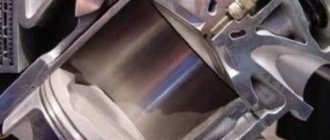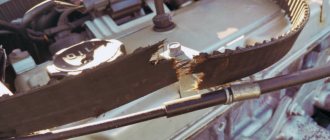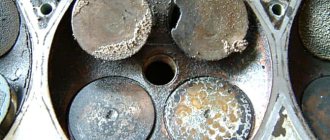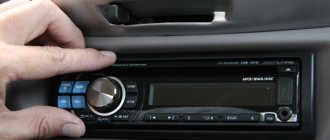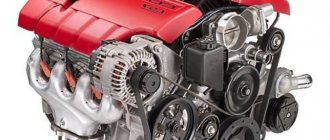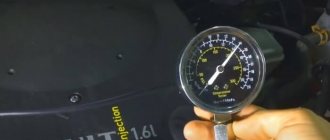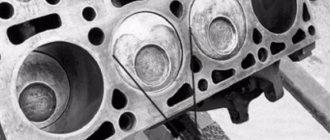Compression is the amount of maximum pressure in the cylinder created when the engine is idling with the starter (for example, when the spark plug is turned off). Engine compression should not be confused with the compression ratio, because these are different concepts.
Compression is a force exerted on a gaseous body, leading to a decrease in the volume it occupies, as well as an increase in pressure and temperature. In the broadest sense of the word, compression is the amount of pressure that is created in the cylinder at the end of the compression stroke.
When diagnosing malfunctions associated with interruptions in engine operation, the first step is to measure the compression. This will give you the right direction for further troubleshooting. You can improve the ignition and fuel supply as much as you like, but if the cylinder is not sealed enough, then it will not work normally. Timely compression measurements can detect cylinder depressurization in the early stages, thus saving money on repairs and time in troubleshooting.
Diesel engines are especially demanding on compression, since in them the fuel ignites without the use of a spark plug. In such an engine, a portion of fuel is injected through a nozzle into air heated from compression in the cylinder (to a temperature exceeding the ignition temperature of the fuel). As a result, if there is no decent compression, then there will be no conditions for ignition of diesel fuel. During the injection of the fuel mixture, it is atomized, and then combustion centers appear around individual droplets of the fuel mixture; as the fuel mixture is injected, it burns in the form of a torch. Since diesel engines are not subject to the phenomenon of detonation characteristic of engines with forced ignition, they can use higher compression ratios (up to 26), which, in combination with long combustion, ensuring constant operating pressure, has a beneficial effect on the efficiency of this type of engine , which can exceed 50%.
Criteria and norms of compression in cylinders
There is a point of view among owners of innovative vehicles that the pressure of a heated internal combustion engine can be from eight to ten atmospheres.
The machines use engines of different configurations, depending on the number of valves and camshafts, the shape of the intake manifold, and the built-in connecting rod-piston system. According to this, its specific level of pressure is determined - this is the ratio of the capacity of the cylinder to the capacity of the combustion chamber.
The higher the compression level, the higher the compression number. For engines running on gasoline, the compression indicator lies in the range of eight to twelve units, which is indicated in the registration certificate of a particular vehicle.
In theory, it is not difficult to calculate what the pressure in the cylinders should be for a particular engine. It is necessary to multiply the compression level by a factor of 1.3.
Insufficient compression: what to do
Operating a vehicle with low pressure in the cylinders leads to damage to the CPG and timing parts. Moreover, the longer you do not take the necessary measures, the more expensive it will ultimately cost to repair the power unit. The most characteristic signs of compression loss:
- the engine became noticeably harder to start;
- engine operation is unstable in all modes;
- glutton of oil;
- fuel consumption has increased;
- the cylinders work poorly (the engine “troits”);
- an increase in pressure in the cooling system: antifreeze will begin to be squeezed out from under its gaskets;
- With a diesel engine, you can hear popping noises when the engine is running.
If the process of wear of timing elements and the cylinder-piston group has not reached a critical level, then you can use special additives that will somewhat delay the overhaul. You can also use a folk remedy, but only when the reason for the decrease in compression is the formation of a dense crust of deposits on the cylinder bore and piston heads. The procedure is as follows:
- Prepare denatured alcohol and kerosene.
- Mix 25 ml of each component in a suitable container (this is the volume of solution - 50 ml - for one cylinder).
- Start the power plant and warm it up, then turn it off.
- Turn out the candles and insert 50 g of the mixture into each hole.
- Leave the vehicle for 12 hours (overnight is possible).
- Inject 4-5 g of motor oil into the cylinders using a disposable syringe, screw in the spark plugs, start the internal combustion engine and let it run for half an hour. During this time, the deposits formed will burn out.
Instead of a mixture of kerosene and denatured alcohol, you can use special products for cleaning carbon deposits, sold in car dealerships. In this case, the algorithm of actions is slightly different:
- Unscrew the spark plugs and pour the purchased solution (30-40 g per cylinder) into the empty holes.
- Cover the holes with a rag to prevent dirt from getting in.
- Leave the car for 10-12 hours.
- Remove the rags and, without screwing in the spark plugs, crank the engine with the starter for 20-30 seconds.
- Clean the spark plugs and screw them in.
- Start the car, warm up the engine and drive out onto the highway. Accelerate the car to 110-130 km/h. At this speed it is recommended to drive 25-30 km.
Attention: do not try to screw in the spark plugs and start the car after filling the fluid in less than 10 hours: the remaining product can lead to water hammer and breakage of the CPG parts. After this, take compression measurements again. If it remains at the same level, then you will have to seriously restore the performance of the engine. This means replacing the rings, the pistons themselves and boring the cylinders (liners) to the nearest repair size.
How to measure compression in an engine
The procedure is carried out with a special device - a compression gauge, which includes the following components:
- Pressure gauge with thread;
- A metal pipe or soft hose with a built-in shut-off valve and an air release button;
- A part for screwing into a cylinder, fed by adapters for other threads or a rubber cone.
The pressure gauge is built into the tube (flexible hose), with a thread on the opposite side. The check valve is necessary to determine the pressure gauge readings, since during testing the piston gains pressure within a couple of crankshaft rotations (about ten).
To control gasoline and diesel internal combustion engines, pressure gauges with different measuring scales can be used. If for engines operating on gasoline a device provided for twenty to twenty-five Bars is sufficient, then to study a diesel engine you will need a scale of at least fifty Bars.
Compressometer
Measuring compression indicators is best done with a compression meter operating on the principle of a pressure gauge. If the latter measures tire pressure and is designed for light loads, then the compression meter is a more powerful unit. Compare the pressure inside the engine and the tire, and then the difference between the two devices will become visible. However, the principle of their functioning is largely similar.
Conventional compression gauge
Today, there are three types of compression meters.
- For gasoline units.
- For diesels.
- A universal option used for diagnosing power units of any car.
In addition to the fact that compression meters come in different types, they also differ in models.
A compression meter is a diagnostic unit that is part of the mandatory tools for maintenance. Experienced motorists use it to analyze the technical condition of the engine without using expensive service stations. A good compression meter allows you to carry out diagnostics yourself, without the help of an assistant, which is also considered a big plus. As soon as I noticed problems with the engine, I took it and checked it.
A prerequisite for a high-quality meter is the presence of a tip on it that allows you to screw the measuring device into the spark plug hole. Without such a threaded output, the measurement accuracy is reduced significantly.
It is also recommended to purchase a meter that is equipped with a compression breather in the tip itself, which is screwed into the spark plug hole. If the valve is located directly below the scale, the readings will be less accurate.
A conventional compression meter is most often used to determine the compression level in garage conditions. However, this measurement can be called uninformative, although it is still possible to clarify the overall picture.
For a more complete diagnosis, it is recommended to carry out the test using special equipment, preferably at a service station. For example, such an installation as the AGC is used to monitor the condition of the CPG. The measurement option is no different from the compression meter, but the AGC helps to measure the vacuum values, not the compression values in the cylinders.
AGC is also used to detect leaks that are associated with the combustion process. The installation helps determine the effectiveness of valve fit, assess the condition of the pistons, and detect coking or stuck rings.
How to measure compression in an engine?
For an initial general assessment of compression in the cylinders of a gasoline internal combustion engine, the following rules must be followed:
- Heated to the optimal temperature;
- Spark plugs are turned out from all cylinders;
- The fuel supply is turned off (on injection engines you need to turn off the crankshaft position converter, on carburetor engines you need to turn off the fuel intake from the fuel pump);
- The generator is fully charged or additionally connected to the starting unit;
- The starter is in working order;
- The clutch pedal is depressed;
- Throttle valve is open;
- The measuring modes for all cylinders are identical in terms of the speed of cranking by the starter (or the number of strokes).
Recommendations
It’s just the Chinese crap that’s overpricing. 16 is the wrong number
Engine compression and compression ratio. What it is?
Compression is the maximum air pressure in the combustion chamber at the end of the compression stroke. The engine compression ratio is the ratio of the total volume of the cylinder to the volume of the combustion chamber. Compression ratio. On a forced engine, depending on the final task, the compression ratio can vary significantly, reaching values of 11 - 11.5. All this is aimed at extracting maximum power from a motor of a specific size. The higher the compression ratio, the higher the power density. True, this will inevitably reduce the service life and sharply increase the risk of problems with the engine when refueling with low-quality fuel. One refueling with questionable fuel can quickly kill a “stressed” engine. So, when boosting the engine, it will not be possible to save on the quality of gasoline. Therefore, when tuning the engine, the compression ratio does not increase very significantly, usually in order to switch to a brand of gasoline that is next to the one already used in terms of octane number. In principle, indirectly, the value of the compression ratio can be judged by the brand of gasoline used - you can drive an AI-80 with a compression ratio of 9.0, and an AI-92 - up to 10.0 (provided that the gasoline meets the declared characteristics). Increasing the compression ratio - a complex process that requires precise calculations and very highly qualified mechanics. Therefore, it is highly not recommended to do this yourself. Compression. As mentioned above, compression is the pressure in the cylinder. This is why compression depends on the compression ratio (the pressure in a smaller volume will always be greater, i.e., as the compression ratio increases, the compression increases). By the amount of compression you can preliminarily judge the condition of the engine.
It is important to carry out the compression measurement procedure correctly. To do this you need: the engine is warmed up, the battery is fully charged, the throttle is open, the air filter is removed, all spark plugs are unscrewed
In this mode, a fully charged battery will allow the starter to spin the engine up to 200 rpm. Compression in all cylinders should be equal. If the compression level decreases, it is necessary to find out the cause of the drop. It could be piston rings or problems in the valve mechanism, you can find out this way. 15-20 grams are injected into the problematic cylinders using a syringe. motor oil. The measurement procedure is repeated. If the pressure gauge readings have increased, the reason for the drop is in the piston rings; if they remain at the same level, it is in the valves.
Go herd the geese, you see he is silent, he has already measured the COMPRESSION, but the degree of compression is not measured, it is CALCULATED!
I taught Pallas's cat that compression and compression ratio are two different things, but we measure compression, and compression ratio is always higher than compression, STUDENT!
What are you talking about?
You got it wrong, if the compression is 11 then the compression ratio is 18, take the manul to school, September 1 is not far away.
There is a conversation, what amperage do you have on the Prior? And look, which one has a diesel engine, so you lamented, and I don’t need to go anywhere, I’m speaking after the fact. A long time ago there was a V8 belt with a 1.3 engine, I installed the piston from the V, and what happened was that everything was fine when it was cold, but when the engine was hot it wouldn’t start, the starter just wouldn’t crank. I measured the compression in the first 15 in the remaining 14, I had to remove the head and put on another gasket, and it became normal everywhere 12 and still drives like that. So throw away this compression gauge, Chinese antlers are not known for the boys who don’t understand anything
And where have you seen a diesel engine, it’s only started from the launcher? And the physics of diesel ignition is a high compression ratio, so don’t bother me, I repair engines, both diesel and gasoline, and I understand a lot. And for example, look under the hood of a Mitsibisi El 200, and you will see 2, I repeat 2, batteries to start the engine.
In short, I’ll replace it with an expensive compression meter in the near future0
gee gee! do you have a diesel engine? In general, if the compression is above thirteen, then something is wrong in the engine. and when it’s hot it’s unlikely to start at 16, the starter won’t crank
Post a video? everything starts up fine
gee gee! do you have a diesel engine? In general, if the compression is above thirteen, then something is wrong in the engine. and when it’s hot it’s unlikely to start at 16, the starter won’t crank
Diesel has at least 23
Naive, I will never believe that there is such compression, because I repair engines.
Source
Compression testing devices
A compression gauge is a unit that contains a pressure gauge with a scale, a pressure relief valve and tips.
The most practical is considered to be an elastic hose with a thread, where a nipple is mounted to prevent air from escaping back out of the device.
The study of compression in internal combustion engine cylinders, which involve spark plug wells in the construction, is carried out by screwing a flexible hose into the threaded slot of the spark plug, which does not allow the passage of compressed air from the leaky contact of rigid tips without threads.
Air leaks
Compressed air tends to leave the cylinder, and this is natural. Accordingly, air leakage is possible through anything that is not hermetically sealed.
Consider the situation of loss of compression due to air leakage.
In order to identify the cause, you must do the following:
- Align the cylinder slightly short of TDC;
- Put the car on the handbrake and engage either 4th or 5th gear;
- Open the oil filler neck;
- Direct a stream of compressed air into the cylinder with a pressure of at least 2, but not more than 3 atmospheres. To do this, you can use either a compressor or an inflated car bladder.
What to pay attention to:
- Hissing and air escaping through the spark plug hole located nearby, which indicates a “breakthrough” of the cylinder block gasket;
- The intake valve is not tightly closed if air hissing from the carburetor is released;
- Air leaking out of the oil filler neck means things are bad. This means that either the piston has burned out or a crack has formed in it;
- If air comes out through the exhaust pipe, check the exhaust valve, it is most likely burnt out.
Also, minimizing air leakage is achieved when:
- The cylinder is completely round, without scratches on its surface;
- The valves are perfectly ground and fit securely to the seats;
- The piston ring locks have minimal clearances;
- The piston rings seal tightly against the cylinder liners and lie tightly in their grooves.
Measure the compression in the cylinders yourself
First, you need to determine from the data sheet what the optimal pressure of a gasoline engine is for a given vehicle and calculate the level of accessibility to the spark plugs.
If the input requires disassembly of other engine components (throttle assembly, intake receiver), which prevent their dismantling and there is confidence in their effective disassembly and reassembly, then measurements can be taken.
Data analysis
If you do everything correctly, you will be able to take correct values. Different types of engines have their own standards, with which it is worth comparing the results obtained.
| Motor type | Minimum value, Bar | Optimal indicator, Bar |
| Old gasoline engines with a compression ratio of up to 8.5 | 11 | 13 |
| New engines, with a compression ratio of 8.5 | 12 | 14-15 |
| Diesel units | 22 | 30 |
How to measure compression
There is a point of view, in order to correctly calculate the pressure in the power unit, you need to turn the crankshaft 2-3 rotations with the starter.
This method leads to illiterate diagnosis of the breakdown and, as a result, to unreasonable expenses for repairing the internal combustion engine.
The study is carried out in various modes for a detailed study of the engine:
- With closed throttle valve;
- With open constipation;
- With the addition of oil fluid to the cylinder;
- On an unheated internal combustion engine.
Not so simple
Please note that we are not talking about the pressure created when the mixture burns. This means that before measuring compression, you need to unscrew the spark plugs so that a spark does not inadvertently form in the cylinders.
It would seem that the concept of compression was clearly defined. However, let's now see how any 4-stroke engine actually works. It will become clear that the compression value on the compression stroke (B) and on the exhaust stroke (D) will be different - on the second of them, the exhaust valve is always open! This means that we will assume that compression is the maximum pressure measured at stroke B.
4 strokes of internal combustion engine
We will measure the value like this: the starter turns the shaft, the mixture is not supplied to the cylinders, and air is pumped by pistons from the intake manifold to the exhaust tract. Let's imagine a graph showing the dependence of pressure on time. The maximum value, that is, the top point on the graph, is the compression value.
Dependence of pressure on phase (0 – TDC compression stroke)
The closing of the intake valve coincides with the passage of bottom dead center (BDC). It is important that in the interval from -10 Gy. up to +10 Gy. relative to BDC, the piston speed will be minimal. And each tooth on the timing belt corresponds to 5 degrees.
Jumping the belt by 1-2 teeth in any direction leads to a subtle change in compression. But there are other obvious reasons leading to its decrease:
- “Lodging” of compression rings in the grooves due to the formation of carbon deposits;
- The appearance of mechanical defects on the valves;
- Loose fit of valves to seats, bending of the valve. Also, the valve may be “pinched” due to carbon deposits;
- General wear and tear of engine parts, when it is concluded that a major overhaul is necessary.
An illustration for points 1, 2 and 4 is shown in the photo:
A lot of carbon deposits - the rings are stuck
Crack on valve disc
Piston edge failure
Before measuring compression, you need to take into account that the appearance of carbon deposits in the cylinders leads to its increase. Using various fuel additives, try to remove carbon deposits, and only then take any measurements.
The formation of carbon deposits, as well as its gradual removal, is a natural process for any engine. Therefore, the advice above is just a common recommendation. It is not so necessary to follow it in 99% of cases.
Compression test with throttle closed
This measurement method is necessary for diagnosing minor damage to the power unit, which is sensitive when there is low air intake into the cylinders.
This could be a break in the valve saucer, a slight burnout of the edge, or a leak in the seat-valve relationship.
- When measuring compression, the air supply through a closed throttle cover is reduced, and its reading will be low (from ten to eleven atmospheres).
- Due to the small amount of air supplied to the cylinders, sensitivity to leaks becomes higher, and as a result, pressure readings decrease.
Main regulatory indicators
All necessary data can be taken from the maintenance documentation for a particular car brand.
Basic data, taking into account testing only on a warm engine, is presented below.
Standard compression level:
- Modern gasoline cars that are filled with A-95, 98 gasoline - from 11 to 14 atmospheres (range of readings from 0.5 to 1.0 atmospheres);
- Old cars filled with gasoline A - 80, A-92 - from 9 to 10 atmospheres (range of readings from 0.5 to 1.0 atmospheres);
- Modern diesel cars - about 45 atmospheres (range of readings from 2 to 3.0 atmospheres);
- Old diesel cars - about 28 atmospheres (range of readings from 2 to 3.0 atmospheres).
Depending on the installed diesel engine, standard readings can vary from 28 to 45 atmospheres.
By checking engine compression, the following faults can be diagnosed.
Measuring with the throttle cover open
To diagnose wear, compression is tested with the throttle cover fully open, ensuring maximum air flow to the cylinders.
An excessive volume of air contributes to an increase in pressure, however, in addition to this, leaks also increase, but in comparison with the amount of supplied air they are so small that the drop in compression is insignificant and amounts to twelve to thirteen atmospheres.
If there are “severe” malfunctions in the engine, then reduce to eight to nine atmospheres.
Supposed reasons:
- Failure or location of the rings in the grooves of the piston;
- Damage to the piston bottom or burnout;
- Significant burnout of the valve plate or change in the shape of its rod;
- As a result of penetration of foreign bodies, scoring of the cylinder surface appeared;
- After repair work on an engine with an expired service life, due to the change of piston rings, the configuration of the cylinders was not taken into account and they were not bored to a different diameter of the piston and rings.
Finding the reasons for low compression
If a decrease in compression is detected in one of the cylinders, the next step is to identify the causes of this malfunction. In general, there are two reasons for a decrease in compression - leaks can occur either through the compression rings or through the valves and their seats. To check who exactly is at fault, you need to pour a little engine oil into the “weak” cylinder (through the spark plug channel) and repeat the compression measurement. The secret is that the added motor oil will reduce the gap in the piston-cylinder pair (when a working cylinder-piston group (CPG) operates, this gap is sealed with rings) and compression will increase. Of course, in an engine with direct injection, it is worth paying attention to the fact that there is a recess in the piston and some of the oil will settle in it (that is, you need to pour enough oil to fill this recess to the brim and overfill it a little). If after adding oil to the cylinder the compression remains the same, then it is necessary to repair the valves (grinding, etc.).
If the compression has increased (when measured with oil), then the rings in this cylinder are to blame. Then there are two ways - either disassembling the engine, or decoking and flushing the oil system. Of course, you should try decoking first. And if it doesn’t help then repair. However, if decarbonization helped in the future, it is worth intensifying monitoring of this cylinder and planning to replace the rings.
Photo instructions on how to measure compression in engine cylinders
Compression value for Chinese cars
The Lifan Motors concern is based in China and produces passenger cars. All engines assembled at its factories are modified copies of Toyota engines. And for them, that is, for Toyota internal combustion engines, information is freely available:
- 1ZZ-FE (Lifan X60, 720) – 13.2;
- 4A-FE (Solano 620) – 13.5;
- 4E-FE (Lifan Smily) – 13 and above.
Values in bar given here are typical for serviceable engines. The motor of the Smily mini-car resembles the 5A-FE unit in appearance. But the cylinder block and SHPG are different - from the 4E-FE engine.
We are talking about measuring compression, so the main unit must be considered the cylinder block.
Hot engine measurement options
There are several types of measuring compression on a warm engine; sometimes drivers use the technique of combining these methods to obtain more accurate data.
Measurements with open throttle
It is more convenient to carry out measurements with the damper open with an assistant who will depress the pedal. Low readings for this measurement will indicate loose valves, defects or wear on the camshaft cam, or a leaky cylinder head gasket.
Read: How does ABS work on a car?
Measurement procedure
It all starts with preparation, as the basis for the competent conduct of any operation. In this case, it includes checking the condition of the engine, since the correctness of the measurement depends on this. For example, if even slight deviations are noticeable in the operation of the motor, they can affect the compression indicator during measurement.
Preparation also includes selecting the necessary tools:
- fully functional battery;
- pipe wrench;
- actually, the compression meter itself.
In some cases, especially for beginners, it is recommended to use the help of an assistant.
The measurement process itself looks like this:
- the motor initially heats up to a temperature of 50-60°;
- the spark plugs are unscrewed from the machine (using a pipe wrench or spark plug wrench);
- The crankshaft sensor is disconnected from the connector;
- the meter lead is screwed into the spark plug hole;
- the assistant turns on the ignition and presses the accelerator pedal;
- after the arrow on the meter stops, you need to write down the data;
- repeat the same procedure on all cylinders.
How to check compression
Why is the sensor disconnected? It's simple. This is done to prevent the controls on the computer from going wrong. In addition, in this way you can turn off the fuel supply to the injectors.
Compression can be measured on both a hot and cold engine.
| Hot engine | 1 cylinder | 2 cylinder | 3 cylinder | 4 cylinder |
| Open throttle and injectors disabled (ODZ) | 12.5 | 12 | 12 | 12 |
| Closed throttle and injectors disabled (ZDZ) | 11 | 10.05 | 10.05 | 11 |
| Open throttle connected injectors (fuel enters cylinders) | 12 | 11 | 11 | 11 |
| Cold engine | ||||
| Open throttle and injectors disabled | 12.3 | 11.5 | 11.5 | 11 |
| Closed throttle and injectors disabled | 12 | 11 | 11 | 12 |
| Open throttle connected injectors (fuel enters cylinders) | 13 | 12 | 12 | 12 |
However, correctly carried out measurements should also take into account leaks that inevitably occur on an injection-type engine. They are measured with another tool - a pneumatic tester.
To eliminate various errors on the injector, it is necessary to carry out measurements based on the position of the throttle assembly.
- First you need to turn off the fuel supply by removing the fuel pump from the system or removing the chips from the injectors.
- Open the throttle valve.
- Rotate the starter until the needle no longer rises.
Thus, the instructions on how to correctly measure compression on an injector tell us the following. It is necessary to measure compression with both the ODZ and the 3DZ. Both measurement methods provide indicators that help identify certain groups of defects.
Let's start with the fact that with ZZZ less air enters the cylinders. This means the pressure will be low. When measuring compression, this must be taken into account, because the parameter can be equal to 0.8 MPa. It turns out that air enters the cylinder in the same quantity as it is lost. Therefore, there is a noticeable drop in compression, even if there is a small leak.
Different throttle positions
A different picture is visible with ODD. There is much more air flow and less leakage. Therefore, the pressure does not drop much - to a maximum of 0.9 MPa. Diagnostics with ODZ makes it possible to detect gross defects observed in the engine.
You can check compression not only using a meter, although it is a compression meter together with other equipment that gives a complete result. You can diagnose the compression ratio using regular engine oil (using a meter, of course).
- Pour about 30 grams of lubricant into the hole from the removed spark plug.
- Check compression.
If it increases sharply, and the difference in its values between the cylinders disappears, it means that not everything is in order with the rings or seals.
What to do if the compression meter measurements do not please you
If at least one of the measurements has a strong deviation from the norm, this may indicate problems with the motor. In this case, the engine needs to be repaired. With reduced data, we can talk about the following malfunctions:
- Wear of pistons, liners and rings (if the indicators are reduced identically). When adding 5 ml of engine oil to the cylinders, the compression should increase - this will confirm the previous analysis of measurements.
- With different indications, there may be a problem with valve leaks.
- Piston destruction in various places (side or center).
All malfunctions due to wear of individual parts are repaired by disassembling and replacing a specific accessory with a new one. However, the best solution would be to replace all valves, since changing one may soon cause the next one to break. The same kit replaces all pistons.
Compression testing is the most effective method of testing the correct operation of the engine. It is the first priority point in the algorithm for checking the main installation of the machine. Based on the data obtained from the compression meter, it is easiest to make a decision - to carry out further inspections and look for the problem, or to proceed directly to the dismantling and detailed repair of the motor itself.
